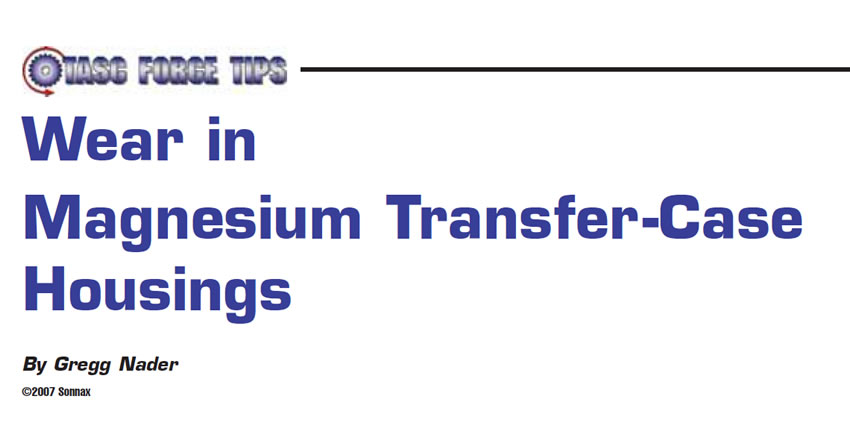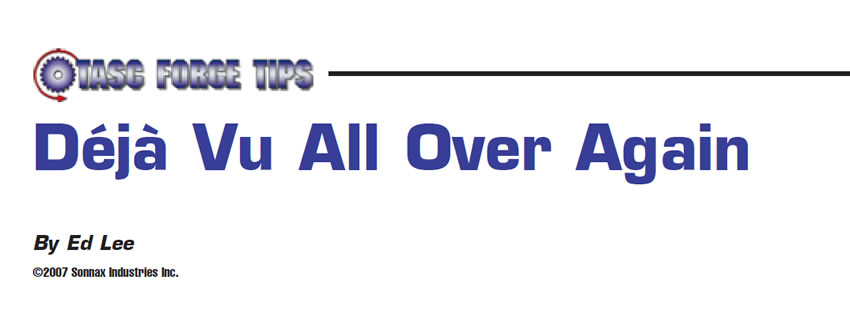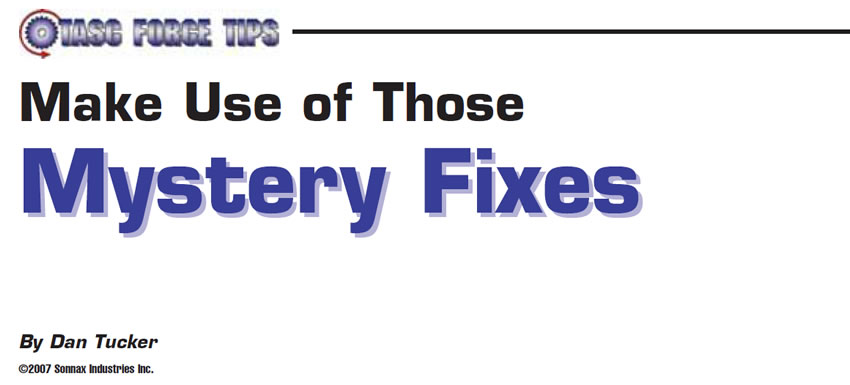Diagnosis with Pressure Gauges
Not too many years ago, before computers found their way into cars, the pressure gauge was the technician’s main diagnostic tool. The pressure gauge can check pump capability, line rise, pressure-regulator and pressure-boost-valve operation, minimum line pressure and maximum line pressure. You can even see a crack in the filter neck on a pressure gauge without pulling the pan! Did you know that with the help of a pressure gauge you can get a good idea of whether non-OEM frictions were used during a rebuild, causing a harsh upshift?

Wear in Magnesium Transfer-Case Housings
One OEM supplier estimates that 2 million transfer-case housings have been made from magnesium1. In the aftermarket, these parts have been working their way into transmission shops at an ever-increasing rate. The questions I discuss here are why magnesium transfer-case housings wear so dramatically while their similar aluminum counterparts do not, and how this affects repair choices.

Food for Thought: How Hot Is Hot?
How long have you been in the transmission business? Have you ever honestly sat down and thought about how an automatic transmission heats up? I mean, how hot does it get and how fast does it get there? Does the temperature stabilize as it does in an engine, or is it always changing? Have you ever taken a car for a nice long drive to be sure you “got it hot” and not been able to reproduce the problem? I’m sure you always figured that stop-and-go city driving creates more heat than driving on the highway, but how much more?

Déjà Vu All Over Again
When GM introduced the stamped-steel drum for the THM 200 transmission, it presented technicians with some new challenges. The 200 direct drums would crack where the inner liner (where the piston lives) was joined to the outer shell. The weld that holds the two members of the drum together is subject to pivotal flexing each time the clutch is applied. Over time, this flexing action will cause a crack at the weld.

A Quick Fix for an Earlier Fix
Do you recall that feeling you get when you first figure out that the transmission on your bench has been worked on before? The signs could be obvious, like a painted case, but other times it’s not until you start tearing it down that you see clues that someone has been there before you. For me it is always a bit of a disappointment, because I know I have to watch carefully for changes that someone else made that could affect the transmission when I’m finished with it.

Make Use of Those Mystery Fixes
With the transmission industry changing almost every day, we have to stay on top of the “3 C’s” if we plan to survive. The 3 C’s, of course, are Complaint, Cause and Correction. But in the transmission business, working through the 3 C’s can leave us a little short of our goal. We can’t quit just because we have found a bad part. Once we understand that a particular part has failed, it may help us to reduce repeat failures if we can understand why it failed.

Catching a Brake on Shift Problems
A 2001 Nissan Altima was brought to a transmission shop with the complaint that the shifter would not move into reverse or park. The customer explained that the vehicle performed just fine when cold but occasionally refused to go into reverse or park after warming up. The shop performed its routine pre-checks and then road-tested the vehicle. The pre-checks didn’t show any codes present (not even a history code), and the technician wasn’t able to reproduce the condition on the road test. The customer was asked to leave the vehicle for further evaluation.

Making Money off the ‘Daily Grind’
No, I’m not talking about our daily routine, but rather a routine we perform daily that not only makes our shop money but also saves valuable time. I’m talking specifically about the salvage and reuse of parts that otherwise would be scrapped, using a piece of equipment many shops already own but may not be using to its fullest potential.

TAAT Reverse Issues
A Saturn with the TAAT comes into your shop with a delay, slip/bang or no reverse at all. What is the first thing you do? Get a valve body. It’s always the valve body. The only thing that goes wrong with a TAAT unit is the valve body. We can do this in an hour or so.

Diagnose with Data
Some folks have not had an opportunity to use data recordings as a diagnostic tool. When you first start looking at recordings, there appears to be so much data that it’s hard to find the answers. There are a few techniques I have found very useful in getting the information I need. The “before” graphs show the readings used to verify the complaint and diagnose the problem.

ZF Tips with a European Flavor
ZF is one of the world’s leading powertrain manufacturers. One of its divisions, in Saarbrücken, Belgium, specializes in producing automatic transmissions for cars.
When you consider working on a ZF automatic, your starting point should be the tag, which leads you to the information and application required for the unit (see Figure 1).

4L60-E Flares on 2-3 Shift (Now What?)
In past TASC Force™ Tech Tips, I have stressed the benefits of testing electrical circuits by measuring current draw. I have also commented that finding new information adds pieces to the puzzle and helps to bring the whole technical picture into better view. This month’s topic is an example of using current-draw testing to uncover an additional cause for 2-3 shift flare on 4L60-E transmissions.

